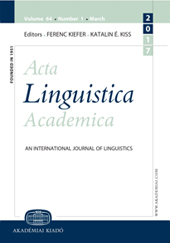Author(s): Hanna Jokela / Language(s): Finnish
Issue: 27/2017
This article focuses on formal subjects in Finnish as a foreign language learners’ texts. My aim is to study sentences, which in Finnish are subjectless, or have a non-typical subject. The prototypical subject in Finnish is in the nominative, agrees with the predicate, and is in preverbal position. In Finnish, however, there are plenty of subjectless constructions and clause types, for example, different expressions of weather and state. In Finnish, formal subjects are not part of these constructions. Tere are also non-typical subjects, such as clausal and infinitival subjects, or partitive subjects in existential clauses. Unlikein many Indoeuropean languages, in standard Finnish, there are no formal subjects (also known as expletives), which are non-referential, “semantically empty”, and formally fulfill the role of subject. Based on my earlier teaching experiences and this study, learners of Finnish tend to add a formal subject, an additional and unnecessary subject, in clauses which in Finnish actually are naturally subjectless, or have a subject which is not a prototypical nominative subject. Multifunctional, diverse and familiar pronoun se is applied by learners in case they have decided to add an additional subject argument.My data comes from International Corpus of Learner Finnish (ICLFI). The majority, 61 %, of formal subject clauses in my data are produced by learners on language skill level B1 or B2. My aim is to provide an overview on additional formal se-subject in learners’ written Finnish. Formal subjects are known in many languages, whereas in Finnish there is a variety of subjectless constructions. This phenomenon is interesting from a point of view of Finnish syntax, and learners’ language.
More...










